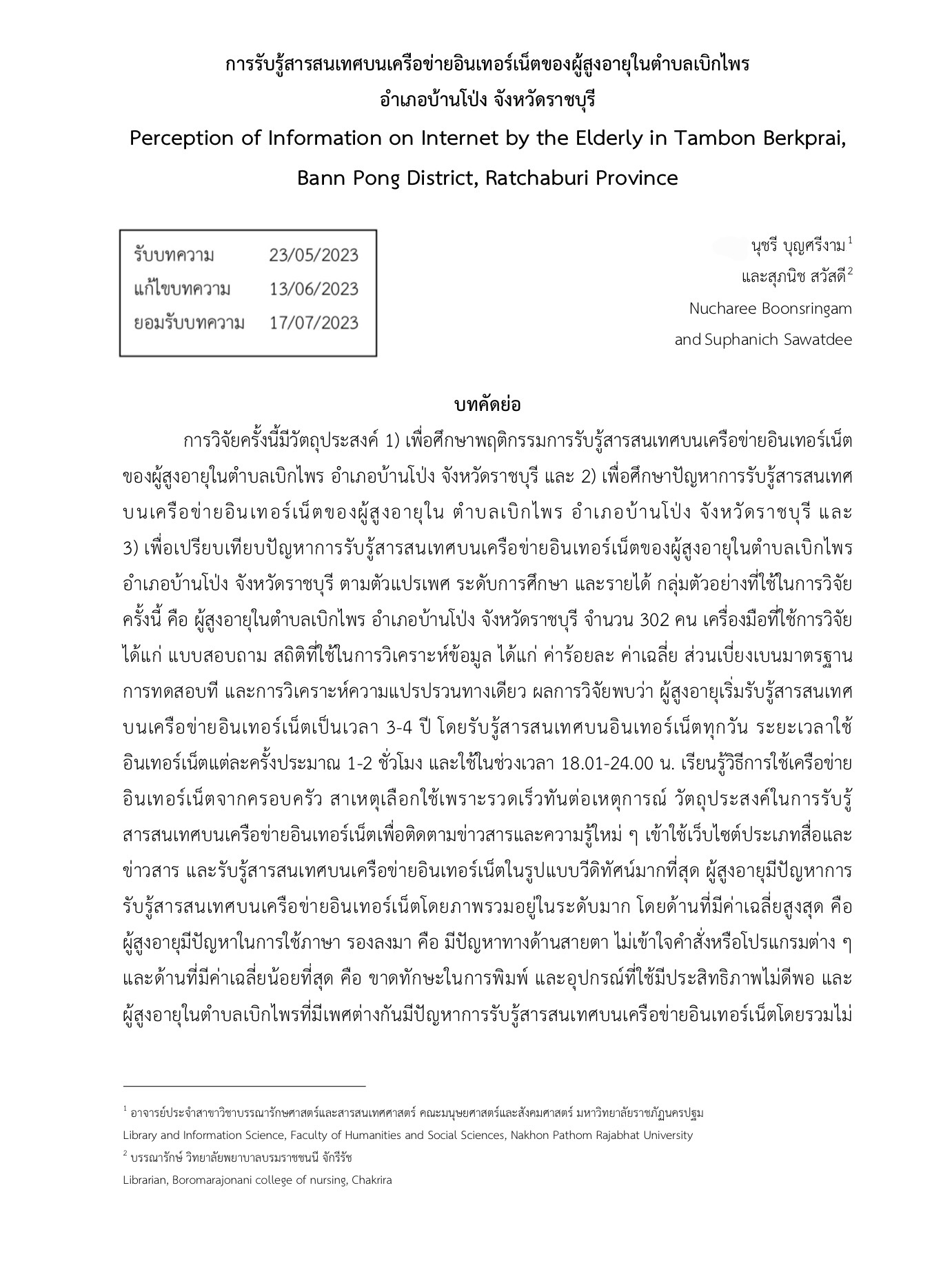Perception of Information on Internet by the Elderly in Tambon Berkprai, Bann Pong District, Ratchaburi Province
Keywords:
information perception, internet network, the elderlyAbstract
The objectives of this research were 1) to study the information perception behavior on the internet network of the elderly in Berk Prai Sub-district, Ban Pong, Ratchaburi province 2) to study the problem of information perception on the internet network of the elderly in Berk Prai Sub-district, Ban Pong, Ratchaburi province and 3) to compare the problems of information perception on the internet network of the elderly in Berk Prai Sub-district, Ban Pong, Ratchaburi province according to gender, education level and income. The sample group used in this research is 302 the elderly in Berk Prai Sub-district, Ban Pong, Ratchaburi province. The research tools were questionnaires. Statistics used for data analysis were percentage, mean, standard deviation, t-test and one-way analysis of variance. The results showed that the elderly began to perceive information on the internet for 3-4 years, receiving information on the internet every day. The duration of using internet is about 1-2 hours and is used during 6:01 PM - 12:00 AM. Learn how to use the internet from family. The reason for using internet because it is fast and up to date. The purpose of receiving information on the internet is to keep track of news and new knowledge by accessing media and news websites and percept the information on the internet network in the form of videos at most. The elderly had overall problems in perception of information on the Internet at a high level. The highest mean was the elderly having difficulty using language, followed by having visual problems, not understanding commands or programs. The least average is the lack of typing skills and the equipment used is insufficient and the elderly in Berk Prai Sub-district with different genders had no difference in overall perception of information on the internet. As for the elderly who have different levels of education, occupation and income, there were problems in perceived information on the internet network at statistical significance at the .05 level.
References
กมลเนตร์ แก้วบุดดี. (2561). การรับสารสนเทศของผู้เกษียณอายุราชการ มหาวิทยาลัยรามคำแหง. วิทยานิพนธ์ศิลปศาสตรมหาบัณฑิต สาขาวิชา
บรรณารักษศาสตร์และสารสนเทศศาสตร์ บัณฑิตวิทยาลัย มหาวิทยาลัยรามคำแหง.
กันตพล บันทัดทอง. (2557). พฤติกรรมการใช้เครือข่ายสังคมออนไลน์และความพึงพอใจของกลุ่มคนผู้สูงอายุในเขตกรุงเทพมหานคร. การค้นคว้าอิสระนิเทศ
ศาสตรมหาบัณฑิต สาขาวิชาการสื่อสารเชิงกลยุทธ์ บัณฑิตวิทยาลัย มหาวิทยาลัยกรุงเทพ.
จักรภัทร เครือฟัก และรุจโรจน์ แก้วอุไร. (2564). สื่ออินโฟกราฟิกกับการเผยแพร่ข้อมูลเพื่อรับมือกับ ภาวะวิกฤติโควิด-19. วารสารศิลปศาสตร์ มหาวิทยาลัย
อุบลราชธานี, 17 (1), 47-66.
โทรคมนาคมแห่งชาติ. (2561). ย้อนรอยอดีต ของอินเทอร์เน็ต มีที่มาที่ไปอย่างไร. ค้นเมื่อ กรกฎาคม 30, 2564, จาก https://www.tot.co.th/blogs/
พรชิตา อุปถัมภ์. (2559). พฤติกรรมการแสวงหาสารสนเทศด้านสุขภาพของผู้สูงอายุ. วารสารปาริชาต, 29 (2), 72-80.
ลฎาภา แผนสุวรรณ์ และจิตาพัชญ์ ไชยสิทธ. (2562). ปัจจัยที่ส่งผลต่อความต้องการเรียนรู้สื่อเทคโนโลยีในยุคหลอมรวมเทคโนโลยี ของผู้สูงอายุในจังหวัด
นครสวรรค์. RMUTT Global Business and Economics Review, 14 (2), 99-117
ศิริพร ชิตพันธ์. (2542, เมษายน-มิถุนายน). การประเมินค่าสารสนเทศจากอินเทอร์เน็ต. ห้องสมุด, 43 (2), 18- 25.
สำนักงานสถิติแห่งชาติด้านการใช้เทคโนโลยีสารสนเทศและการสื่อสาร. (2562). “สูงวัย” ยุคใหม่หัวใจติดเน็ต. ค้นเมื่อ กันยายน 4, 2564, จาก
https://www.bangkokbiznews.com/news/detail/ 854410
สิทธิชัย คูเจริญสิน. (2558). การศึกษาพฤติกรรมการใช้สื่อสังคมของผู้สูงอายุที่พักอาศัยในเขตอําเภอเมือง จังหวัด ชลบุรี. วิทยานิพนธ์การศึกษามหาบัณฑิต
สาขาวิชาการศึกษาและพัฒนาสังคม บัณฑิตวิทยาลัย มหาวิทยาลัยบูรพา.
สุพัตรา คชาทอง. (2545). การใช้อินเทอร์เน็ตของผู้สูงอายุ: กรณีศึกษาสมาชิกกลุ่ม OPPY Club. วิทยานิพนธ์ศิลปศาสตรมหาบัณฑิต สาขาวิชา
บรรณารักษศาสตร์และสารนิเทศศาสตร์ บัณฑิตวิทยาลัย มหาวิทยาลัยรามคำแหง.
สุรพงษ์ คงสัตย์ และธีรชาติ ธรรมวงค์. (2551). การหาค่าความเที่ยงตรงของแบบสอบถาม (IOC).ค้นเมื่อ เมษายน 25, 2565, จาก https://www.mcu.ac.th.
อารีย์ มยังพงษ์. (2556). รายงานการวิจัยเรื่อง สภาพและความต้องการการฝึกอบรมด้าน ICT ของผู้สูงอายุในเขตกรุงเทพมหานคร. กรุงเทพฯ: สาขาวิชาระบบ
สารสนเทศ คณะบริหารธุรกิจ มหาวิทยาลัยเทคโนโลยีราชมงคลพระนคร.
อารีย์ มยังพงษ์ และเกื้อกูล ตาเย็น. (2559). รายงานการวิจัยเรื่อง ปัจจัยที่ส่งผลต่อ ความต้องการเรียนรู้สื่อเทคโนโลยี ของผู้สูงอายุในยุคหลอมรวมเทคโนโลยี.
กรุงเทพฯ: คณะบริหารธุรกิจ มหาวิทยาลัย เทคโนโลยีราชมงคลพระนคร.
อารียา ศรีแจ่ม. (2562). ปัจจัยที่ส่งผลต่อการเข้าถึงเทคโนโลยีของผู้สูงอายุในยุคดิจิทัล. วิทยานิพนธ์ เศรษฐศาสตรมหาบัณฑิต สาขาวิชาเศรษฐกิจดิจิทัล
บัณฑิตวิทยาลัย มหาวิทยาลัยรังสิต.
Cronbach, L. J. (1974). Essentials of psychological testing (3rd ed.). New York: Harper and Row.
Yamane, T. (1973). Statistics: An introductory analysis (3rd ed.) New York: Harper and Row.

Downloads
Published
How to Cite
Issue
Section
License
Copyright (c) 2024 Journal of Humanities and Social Sciences Nakhon Pathom Rajabhat University

This work is licensed under a Creative Commons Attribution-NonCommercial-NoDerivatives 4.0 International License.
Journal of Humanities and Social Sciences Nakhon Pathom Rajabhat University





